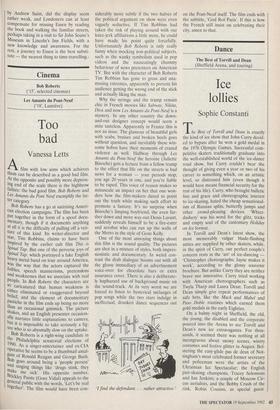Dance
The Best of Torvill and Dean (Sheffield Arena, and touring)
Ice lollies
Sophie Constanti
The Best of Torvill and Dean is exactly the kind of ice show that John Curry decid- ed to bypass after he won a gold medal in the 1976 Olympic Games. Successful com- petitive skaters traditionally graduate into the well-established world of the ice-dance road show, but Curry couldn't bear the thought of giving even a year or two of his career to something which, on an artistic level, so distressed him (even though it would have meant financial security for the rest of his life). Curry, who brought balletic line and grace and choreographic interest to ice-skating, hated the cheap sensational- ism of Russian splits, butterfly jumps and other crowd-pleasing devices. 'Whizz- dashery' was his word for the glitz, tricks and empty soul of the customary Holiday on Ice format.
In Torvill and Dean's latest show, the most memorably vulgar blade-flashing antics are supplied by other skaters, while, in the spirit of Curry, our perfect couple's concern rests in the 'art' of ice-dancing 'Christopher choreographs; Jayne makes it work', according to the glossy souvenir brochure. But unlike Curry they are neither brave nor innovative. Curry tried working with American choreographers such as Twyla Tharp and Laura Dean: Torvill and Dean simply give repeat performances of safe bets, like the Mack and Mabel and Paso Doble routines which earned them gold medals in the early Eighties.
Ou a balmy night in Sheffield, the old, the young, the disabled and the corporate poured into the Arena to see Torvill and Dean's i new ice extravaganza. For thou- sands, t seemed there was nothing at all incongruous about snowy scenes, wintry costumes and festive glitter in August. Bol- stering the easy-glide pas de deux of Not- tingham's most celebrated former secretary and policeman were the artists of the Ukrainian Ice Spectacular; the English pair-skating champions, Tracey Solomons and Ian Jenkins; a couple of Moscow Cir- cus aerialists, and the Bobby Crush of the rink, Robin Cousins, as special guest.
Cousins is the most daring and agile skater in the show, but with 12,000 square feet of ice at his disposal and a thousand comput- erised lights casting him in various hues, he soon becomes just another faceless dot on the landscape. The whizz-dashery is all in the show's technology: a £1 million sound system and a sprinkler system which is acti- vated for the rain-themed finale, complete with thunder and lightning effects.
- Act I opens with The Skaters' Waltz, an Edwardian Christmas card-style village gathering on a frozen lake. How ironic that Frederick Ashton's ballet Les Patineurs, created more than 50 years ago, is a far more resonating study of the motion of blades on ice. As a piece about skating, The Skaters' Waltz reveals nothing about how it feels to skate (or waltz) and its characters are the same neutral 'helpers' who deco- rate and frame almost every other number in this show: a skating corps de ballet flow- ing in and out of a black tent at one end of the arena, adding gaudy colour, neat lines and inane smiles.
The loudest applause greets the stars: Cousins in his showtime-, jazz- and blues- inspired solos; Solomons and Jenkins in their virile-man-holds-up-little-blonde-for- the-world-to-admire duets; and, of course, Torvill and Dean, who, eight years on, are still churning out their greatest hit, Bolero. But it is the Ukrainians who link everything together with their Russian and Ukrainian Suites, Eastern Dance and Rose Waltz regimented displays of skirt-swinging, Cos- sack barrel turns and hands-on-hips vivaci- ty. Titles are kept simple to the point of banality: Two Friends, Lyrical Ladies, Step- ping Out. Still, after a while, it all starts blending into one great medley of costume and hairstyle changes with the same floor patterns, same spins, same dynamic range repeated over and over again, just in a dif- ferent order.
Breaking the evenness and indivisibility of all this were the Moscow Circus husband and wife high-wire walkers, Adam and Aina Visitayev, whose death-wish speciality is a double act at 35 feet with no safety net. At the Arena, the high wire was rigged over the edge of the rink. Falling off, which Mr Visitayev almost did at one point, offered the choice of landing either on ice or on concrete. And that is all you kept imagining as the couple performed their various acrobatic tricks and contortions, their faces paralysed in grimacing expres- sion as each task was methodically com- pleted. The Visitayevs' colleague, Mikhail Matorin, was less determined to tumble to his death, offering us a divertissement with the no-nonsenst, title Gymnastics in a Cube. Strung up over the ice by his wrists, Maturin spun around inside a large cubic frame, assisted by three black-clad Jezebels. Wearing white tights and striking preposterous, grandiloquent attitudes, he looked, for a few seconds, like Freddie Mercury surveying Sheffield from heaven. Really whizz-dash.



























































 Previous page
Previous page